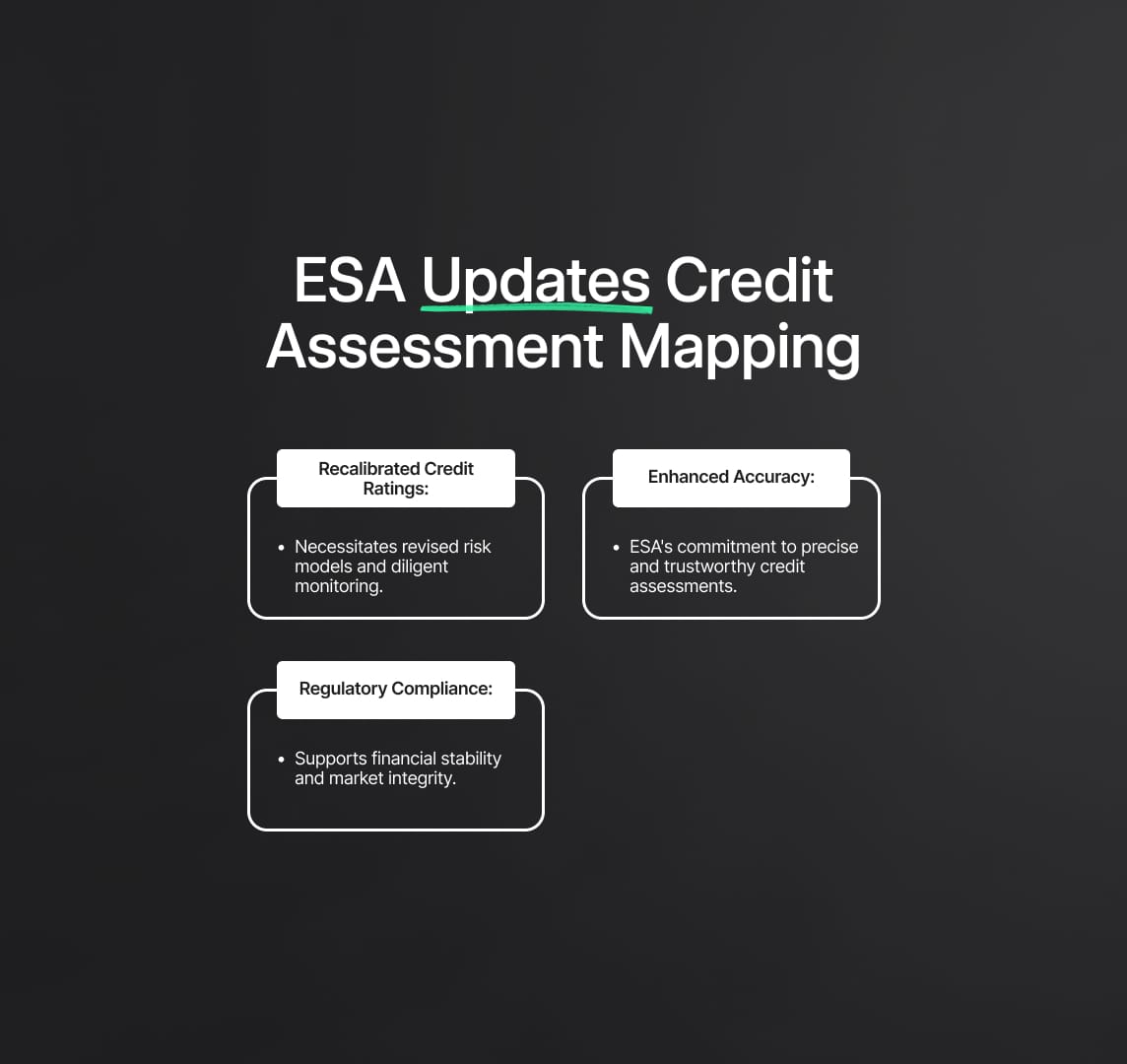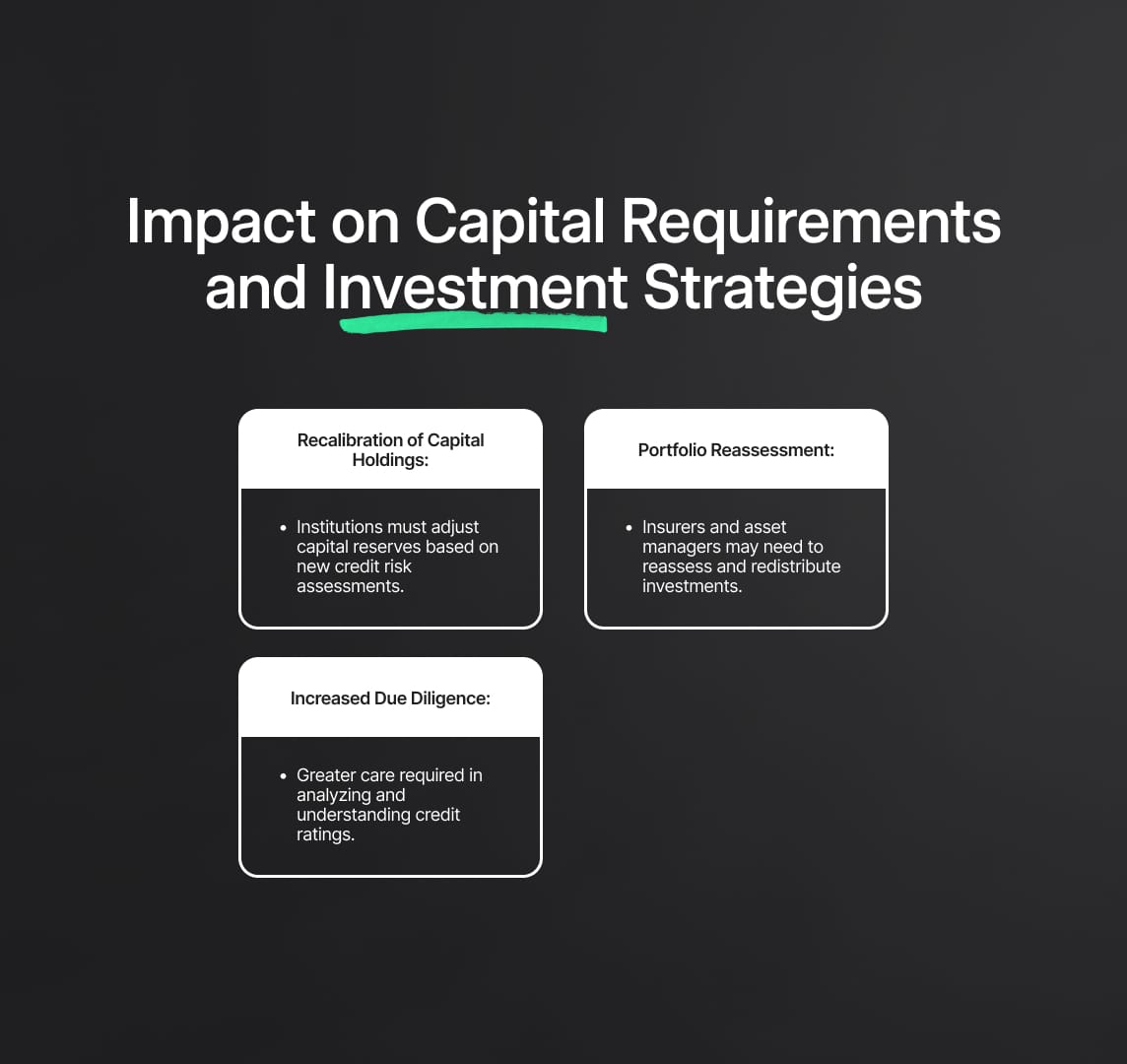Credit Risk: ESA Update Credit Assessment Mapping
The ESA's updates to ITS on ECAIs mark a major advancement in EU credit risk management. Key impacts include recalibrated credit ratings affecting banks, insurers, and investment firms. This necessitates revised risk models, diligent monitoring, and staff training.

Credit Risk: ESA Technical Standards for the Mapping of External Credit Assessment Institutions
Significant updates to their Implementing Technical Standards (ITS) have been announced by the European Supervisory Authorities (ESA), a crucial regulatory body that consists of the European Securities and Markets Authority (ESMA), European Insurance and Occupational Pensions Authority (EIOPA), and European Banking Authority (EBA). In terms of credit risk management and financial stability inside the European Union, these updates are mostly focused on the recalibration and improvement of credit ratings carried out by External Credit Assessment Institutions (ECAIs).
The ESA has taken significant action after a thorough review process that includes the deregistration of three credit rating agencies (CRAs) and an assessment of the efficacy of credit rating maps as of right now. Among these is the suggestion of changes to the four ECAIs' credit quality step (CQS), a move that demonstrates a stronger commitment to precise and trustworthy credit risk assessment. In addition, the ESA has suggested that seven more ECAIs be assigned new or altered credit rating scales. The ESA's commitment to improving the accuracy and applicability of credit evaluations used throughout the EU's financial environment is demonstrated by this strategy update.
These developments hold special significance for European Union financial institutions, whose capital requirements are mainly reliant on external credit assessments. Strict adherence to upholding high standards in credit risk assessment is demonstrated by the ESA's insistence on only utilizing evaluations from accredited, well-known organizations. Since correct credit assessments are essential to risk management and guaranteeing the soundness of financial activities, this is critical for the health and stability of the financial markets.
Moreover, the revised ITS by the ESA demonstrate a more comprehensive dedication to coordinating credit evaluation procedures with changing market circumstances and legal mandates. The Exchange System for Accounting Information (ESA) is a critical component in protecting the financial ecosystem from potential risks and vulnerabilities by regularly reviewing and modifying the mappings of credit assessments by ECAIs.
To sum up, the latest modifications to the Implementing Technical Standards by the ESA, which center on the External Credit Assessment Institutions' credit rating recalibration, represent a major advancement in the improvement of credit risk management in the European Union. In addition to guaranteeing adherence to legal requirements, these modifications support the general stability and dependability of the financial markets. Because of this, they are extremely significant to investors, regulators, and financial institutions alike, enhancing the ESA's position as a crucial watchdog over the European financial industry.

Enhanced Credit Risk Management in EU Financial Institutions
Credit risk management in the European Union has advanced significantly with the recent recalibration of credit ratings by the European Supervisory Authorities (ESA), with a particular emphasis on External Credit Assessment Institutions (ECAIs). This is a hugely significant development for a variety of financial organizations since it completely changes how they manage credit risk. It is imperative to comprehend and adjust to these developments since crucial financial decisions are dependent on external credit evaluations.
- Banks and Credit Institutions: The recalibration of credit ratings directly affects these firms. These ratings are used by banks to assess the risk weight of their holdings, which in turn affects Basel III capital requirements. Their approaches to capital adequacy and risk exposure must be reevaluated in light of the revisions. Institutions need to closely examine how credit rating fluctuations impact their balance sheets and modify their lending policies as necessary. This is an essential component of risk management, not just a compliance exercise.
- Insurance Companies: Insurance businesses are impacted by the recalibration, especially in terms of their investment and risk management plans. Credit ratings are frequently used by insurance companies to evaluate the credit risk of their investment portfolios, which has an immediate effect on their solvency positions. Asset allocations may need to be adjusted as a result of the new credit ratings because some securities may now have different risk weights. This means that in order to stay in compliance with the Solvency II requirement and guarantee consistency with the new risk landscape, their investment strategies must undergo a thorough assessment.
- Investment Firms and Asset Managers: The updated credit ratings are essential for asset managers and investment businesses to make well-informed investment choices. The recalibration may change how different bonds and securities are judged to be risky, which could affect portfolio management tactics. It is imperative for firms to exhibit agility in adapting their investment strategies to maintain portfolio optimization within the framework of updated credit risk assessments. This entails keeping an eye on market developments proactively and being prepared to reallocate resources as the credit environment changes.
The European Union: A Key Regulatory Jurisdiction for Credit Assessments
As the main regulatory body affected by these changes, the European Union shows initiative in improving credit risk management procedures. The updates from the ESA show a dedication to preserving the integrity and stability of the EU's financial markets. These modifications, which are intended to precisely address the distinct regulatory framework and financial landscape of the region, must be complied with by financial institutions operating within the European Union. This regional focus is essential because it guarantees that the standards established are applicable, efficient, and customized to meet the demands of the European market.
Financial institutions operating in the European Union rely heavily on the updates provided by the European Supervisory Authority (ESA) to help them manage the intricacies of credit risk. The accuracy of these updates demonstrates the European Union's commitment to maintaining strict guidelines for financial operations, guaranteeing efficient risk management, and preserving financial stability. Therefore, in order to maintain their business operations and good name in the marketplace, financial institutions operating in the EU need to be alert to these developments and flexible in responding to them.
Regulatory Framework: CRR, CRD IV, and Solvency II Directive
The Capital Requirements Regulation (CRR) and Directive (CRD IV) and the Solvency II Directive are two important pieces of EU legislation that are closely related to the reforms made by the ESA. As the cornerstone of the EU's financial regulatory architecture, these rules provide the requirements for capital adequacy and risk management.
- Capital Requirements Regulation (CRR) and Directive (CRD IV): A key component of how banks and other credit institutions manage their capital and risk is the CRR and CRD IV. The portions of the ESA that deal with using external credit ratings to risk-weight assets are the ones that are impacted by the revisions. Since ECAIs' credit rating recalibrations directly affect asset risk weights, banks' capital needs may shift significantly as a result. This means that internal risk models need to be carefully examined and possibly revised in order to make sure they appropriately reflect the current credit risk environment.
- Solvency II Directive: The Solvency II Directive sets capital standards for insurance businesses, emphasizing the amount of capital they need to hold to lower the risk of insolvency. Since credit risk assessments affect how much assets and liabilities are worth, the directive is extremely sensitive to them. Insurance companies may need to review their capital allocation and risk management plans if credit rating changes have an impact on the computations used to determine the solvency capital need. In order to preserve compliance and financial stability, these businesses must keep a careful eye on these developments and modify their plans as necessary.
Impact on Capital Requirements and Investment Strategies
The capital requirements and investment strategies of the EU financial industry are significantly impacted by the credit rating updates issued by the European Supervisory Authority (ESA).
- Recalibration of Capital Holdings: It might be necessary for financial institutions, especially banks, to adjust their capital reserves in order to conform to the most recent credit risk assessments. In order to recalibrate, it is necessary to examine how new credit ratings affect risk-weighted assets, which has an immediate impact on the amount of capital that must be retained as a safety net against possible losses. Institutions will need to thoroughly examine their asset portfolios in order to spot any changes in the amount of capital needed and make the necessary adjustments to their capital holdings.
- Portfolio Reassessment: The updated credit ratings may force insurers and asset managers to reassess their investment portfolios. Assets may be redistributed as a result of changes in the creditworthiness of securities, which would affect the risk-return characteristics of different investments. This could entail increasing exposure to assets that are judged more creditworthy based on the updated evaluations or selling certain assets.
- Increased Due Diligence: An increased degree of care is needed to analyze and comprehend credit ratings in light of their recalibration. To properly understand the consequences of the credit ratings, financial institutions need to dig deeper into the methods and presumptions that underpin the ratings. In order to guarantee that institutions are not exposed to unanticipated credit risks and are making well-informed decisions based on the most accurate and current information, there has been an increased focus on due diligence.

Mitigation Strategies for Compliance and Risk Management
In the face of these regulatory updates, financial institutions within the EU must adopt robust mitigation strategies to ensure compliance and effective risk management.
- Update Risk Models: Aligning internal risk assessment models with the updated credit rating scales is one of the main initiatives. To make sure the models appropriately represent the modifications in credit risk assessments, a thorough evaluation and adjustment process is necessary. Technical tweaks are necessary, but so is a thorough comprehension of the underlying risk characteristics and how they may have changed as a result of the recalibration of credit ratings.
- Continuous Monitoring: It is essential to regularly examine how rating adjustments affect portfolios and capital needs. Institutions are able to stay ahead of possible hazards and quickly modify their plans thanks to this ongoing scrutiny. It entails closely monitoring regulatory updates, market trends, and the financial stability of the businesses to whom they are exposed. Continuous observation is necessary to spot patterns, deviations, or new threats that can call for more tactical alterations.
- Staff Training: It is imperative to guarantee that all staff members, particularly those occupying risk management and compliance positions, comprehend the ramifications of these modifications. To inform employees about the new credit rating techniques, the rationale behind these modifications, and how they affect the institution's operations, training programs must to be put in place. Employees with this information are better equipped to make decisions and the organization as a whole benefits from a culture of compliance and risk awareness.
Timeline for Implementing Changes and Ongoing Adaptation
There are several stages involved in putting these changes into practice and adjusting to the new credit risk environment.
- Immediate Review: An immediate and comprehensive examination of the ESA's updates is part of the first step. This entails comprehending the precise modifications, determining the impacted regions, and evaluating the instant ramifications for the organization. Gaining a thorough grasp of the new requirements and getting ready for the upcoming stages of implementation should be the main priorities.
- Medium-term Adjustments: Financial institutions will have to modify their risk models and compliance processes in the coming months. Implementing the plans created in the first review phase is the focus of this medium-term phase. It consists of portfolio realignments, revisions to compliance standards, and technical modifications to risk models. This stage is essential to ensuring that institutions are both compliant and in a position to successfully manage the constantly changing landscape of credit risk.
- Long-term Monitoring: The long-term phase entails constant adjustment to market developments and credit rating standards modifications. This necessitates a dedication to remaining up to date on market developments, legislative changes, and economic aspects that may affect credit risk evaluations. To guarantee continued compliance and efficient risk management, regular assessments and modifications to risk management procedures will be required.
Future of Credit Assessment and Regulatory Compliance in the EU
The ESA's updates indicate a progressive future for credit assessment and regulatory compliance in the EU.
- Enhanced Financial Stability: The financial stability of the EU banking sector is anticipated to be considerably improved by the more precise and trustworthy credit assessment mappings. These modifications help to create a stronger and more resilient financial system by guaranteeing that capital requirement computations are founded on a thorough understanding of credit risk.
- Nuanced Credit Rating Approach: A more advanced and improved method of assessing credit risk is suggested by the release of new rating scales for a number of ECAIs. A more accurate picture of an entity's creditworthiness is made possible by this sophisticated assessment, which helps people make smarter financial decisions.
- Increased Regulatory Vigilance: A higher degree of regulatory inspection and oversight is shown by the revocation of mappings for some deregistered ECAIs. With this action, the ESA is demonstrating its dedication to upholding the credibility of the credit assessment procedure and guaranteeing that financial computations are only influenced by ECAIs that are compliant and active.
- Alignment with EU Single Rulebook: These initiatives are aligned with the EU Single Rulebook's overarching goals, which include creating a solid, safe, and uniform regulatory framework for the whole EU. These changes improve the overall resilience and reliability of the EU financial industry by helping to harmonize regulatory standards.
In conclusion, the stability and integrity of the European financial markets depend heavily on the ESA's dedication to improving credit evaluations and controlling credit risk. The improvements that concentrate on credit risk management and External Credit Assessment are crucial for investors, regulators, and financial institutions operating in the European Union. In order to maintain the resilience and strength of the EU financial industry, proactive adaptation to these changes will be essential.

Reduce your
compliance risks

